Shanghai’d
I was reading in the local paper yesterday something I should have known: China’s economic renaissance began 30 years ago when Deng Xiao-ping “opened” China to economic development. The changes in lifestyle have been enormous, and, as I’ve said, every time I come back I marvel how much change has occurred, even in the year or two since my last visit.
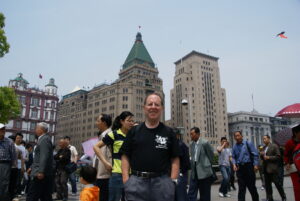
Probably no city has changed more than Shanghai. We’re here as long as anywhere on the trip, but “here” is as modern as anywhere in the world. As the former prime minister of Singapore pointed out, when Hong Kongers noted the rivalry between the two city-states, “I’d worry about Shanghai, not Singapore.” Like probably every city I’ve been to, it’s a melange of colors, a far cry from the 1990 visit, when the colors were dominated by gray, olive, and blue–the colors of the “Mao jacket.” And with its assortment of high rise after high rise, and some impressive architecture, including one building that looks like the yoga position, “mountain,” more “modern.” The Shanghai leaders who went to Beijing after 1990 have reversed the disdain and ignorance (literally) of Shanghai which caused the Maoists to let it alone.
Here’re some quick vignettes about business and how “socialist (no one wants to call themselves capitalist) with Chinese characteristics” this place has become:
First, we’re staying in a hotel that’s not on the Web. Partly that’s because it’s pretty far from the places foreigners frequent (my GPS says 15 miles!). In part, though, it’s because the Chen Yuen is a former guest house run by the People’s Liberation Army. I’ve seen the figures on the percentage of business that the PLA ran (at one time, I recall it was 30% or so). Our guide told us it’s now a tourist hotel because the Army is under orders to “turn a profit” on its businesses, one of the consequences of the economic opening 30 years ago, and the joining of the World Trade Organization in 2001. By the way, it’s a reasonably nice hotel with big rooms, some amenities including ESPN Asia (ever watch a cricket match?), and not many people who speak English. It does have free Internet, so I’ve been able to borrow Dr. Park’s computer overnight, and when I get up early, continue the blog.
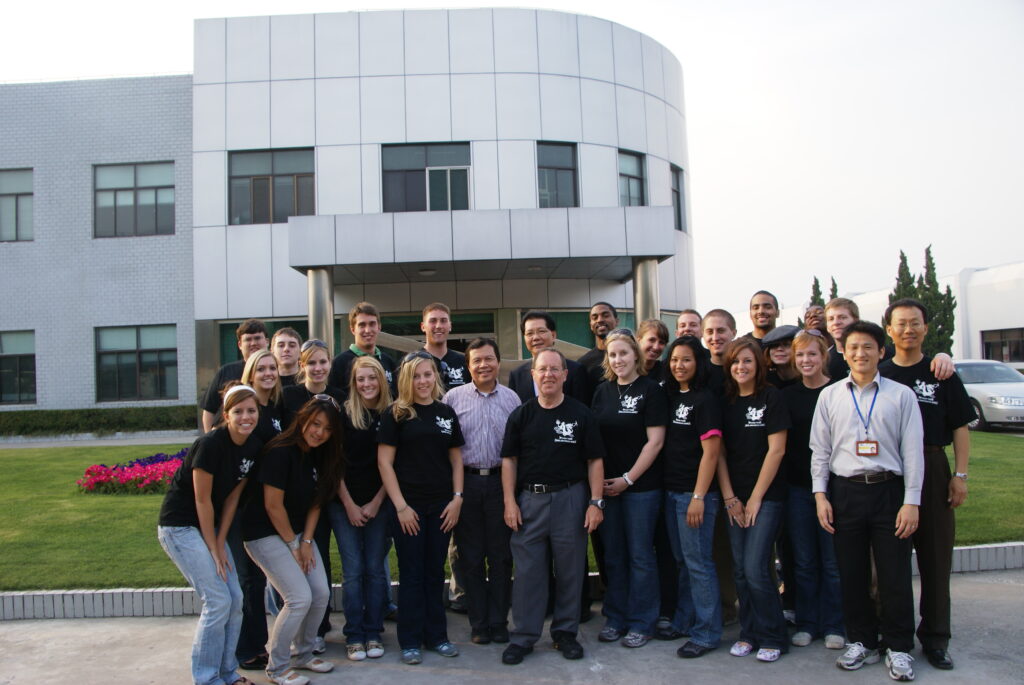
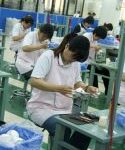 Second, our business visit was to Mizuno, a wholly-Japanese owned company that makes sporting goods. Some of you who play baseball or softball might recognize them from the quality of their gloves. We (IWU) recognize them because of the quality of their management–I think it’s the VP Finance in Osaka, the home of Mizuno, who graduated IWU, and his son, who graduated two years ago.
Second, our business visit was to Mizuno, a wholly-Japanese owned company that makes sporting goods. Some of you who play baseball or softball might recognize them from the quality of their gloves. We (IWU) recognize them because of the quality of their management–I think it’s the VP Finance in Osaka, the home of Mizuno, who graduated IWU, and his son, who graduated two years ago.
 The factory employs about 1,500, with an average salary
The factory employs about 1,500, with an average salary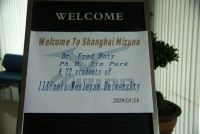 of $200 a month. It sounds like they also pay some benefits. The plant managers were most proud of their low turnover in what looks like a pretty repetitious job. Although the plant is highly automated (and one might have suspected, very clean!), automated means someone puts a baseball in a machine and the machine stitches it. And people (mostly women–the plant has 80% women) then hand stitch the balls, or the mitts, or hand glue the golf club heads to the shaft (“come and get shafted,” I quipped). Bear in mind one important fact, which I just read about in the Far Eastern Economic Review (but not in the Pantagraph, o
of $200 a month. It sounds like they also pay some benefits. The plant managers were most proud of their low turnover in what looks like a pretty repetitious job. Although the plant is highly automated (and one might have suspected, very clean!), automated means someone puts a baseball in a machine and the machine stitches it. And people (mostly women–the plant has 80% women) then hand stitch the balls, or the mitts, or hand glue the golf club heads to the shaft (“come and get shafted,” I quipped). Bear in mind one important fact, which I just read about in the Far Eastern Economic Review (but not in the Pantagraph, o r anywhere else in the U.S.): to protect workers’ rights, the Chinese government has raised the minimum wage–to the point where factories in the Southern Province of Guangdong have closed and/or moved to Viet Nam, Indonesia, and Thailand. It may be a development worth watching in terms of China as the manufacturer to the world.
r anywhere else in the U.S.): to protect workers’ rights, the Chinese government has raised the minimum wage–to the point where factories in the Southern Province of Guangdong have closed and/or moved to Viet Nam, Indonesia, and Thailand. It may be a development worth watching in terms of China as the manufacturer to the world.
I think I mentioned that 1,000 cars a day join the traffic jam in Beijing. Shanghai boast that its traffic jams are worse (and they certainly were 15 years ago, hands down!) but today those jams are on expressways, not streets in the old French Concession meant for Model T Fords or horses. There’s also (and I’ve only seen this in Japan), occasional maps that indicate where the traffic jams are (in red), where traffic jams are slow (in yellow), or where you can weave in and out of traffic trying to see how close you can come to being annihilated (I don’t think anyone ever fails the driver’s exam, which costs $500—2-l/2 months wages for the Mizuno factory workers). I even saw a drive-through in McDonald’s, though there are some interesting stories on how the Chinese don’t know how to use them–driving through, ordering, and going inside to eat, for example.
Finally, I’ve been to two “marts.” One is Walmart, the other a local variety. The Walmart in Xi’an stopped me from taking pictures (fortunately, not until after I snapped a few for my distribution class). I liked the terracotta warrior at the entrance. We were able to visit only the grocery  store at Wal-Mart, but that was interesting because I think food is very cultural (good thing we didn’t have any of the squeamish with us; it was early on one of my walks, and I went with Dr. Park). Besides live, they had chicken feet and cooked dumplings and lots of other things that you don’t find in regular grocery store in the states. It was nice in those two marts to see what Chinese buy, instead of being taken to the massive “outlet stores” that sell essentially the same knockoffs and are frequented by the same foreigners you see at all the sights. Don’t buy the look-alike memory cards, Dr. Park and I learned. Mine was good for ten shots.
store at Wal-Mart, but that was interesting because I think food is very cultural (good thing we didn’t have any of the squeamish with us; it was early on one of my walks, and I went with Dr. Park). Besides live, they had chicken feet and cooked dumplings and lots of other things that you don’t find in regular grocery store in the states. It was nice in those two marts to see what Chinese buy, instead of being taken to the massive “outlet stores” that sell essentially the same knockoffs and are frequented by the same foreigners you see at all the sights. Don’t buy the look-alike memory cards, Dr. Park and I learned. Mine was good for ten shots.
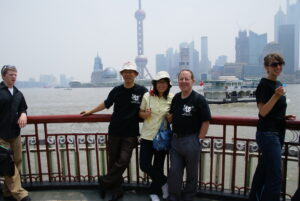
As for Shanghai, I wrote David Hoyt three years ago that he’d never been here, but in some ways I’d never been here either–that’s the difference that a year or two makes. It’s been the most commercial city in China since it wrested from the Chinese as a foreign settlement in the 1840s. In the International Settlement (the British and American areas combined, and the small foreign population essentially ruled the area until World War II), and the French Concession (the French consul general ruled here), industry grew, so much that after 1949, many Shanghainese fled to Taiwan or Hong Kong, and help make those two Chinese areas bastions of industry. The city itself was suspect during the craziness of the later Mao years because it had so many capitalist roaders (as they were called during the cultural revolution, and frequently beaten to death–see Life and Death in Shanghai for an interesting memoir); it is one of the great ironies here (and there are many) that you can buy dolls with dunce caps ala Cultural Revolution period!
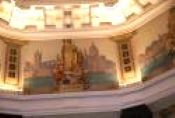
Some of the old is still here–and again, it’s one of the ironies–and even improved. Yesterday, I got us taken to the Bund, the area most foreigners  visit, and the lucky ones stay near. It’s the waterfront area which, during the colonial days, had the impressive architecture that marked the permanence with which foreigners thought they would stay here. If you’ve seen “Empire of the Sun,” you’ve seen the facades which are still present. Most of the buildings on Puxi, the western bank of the Whangpu River, were built before 1930. The Chinese have erected historical markers, officially making these buildings part of their “heritage.” My favorite, the Peace Hotel (built in the 1920s by opium magnate Sassoon, and Indo-Persian) was unfortunately closed, but as I recalled, the former Hong Kong and Shanghai Bank Building had been renovated (when the British were driven out, the Bank housed the municipal government, which subsequently built a palace near the Shanghai museum–at the site of the former racetrack!). During the renovation, they discovered the murals on the dome had been painted over; in a country which can afford painstaking labor, the Chinese got the paint off, and revealed the elegance that only the old world and old times could afford. I managed to snap a picture of “London” before the guard told me “no pictures.” I hadn’t been there before, and of course our guide had never been there. It’s fun being a guide (the guides tell me, with some admiration, that I’m really Chinese.)
visit, and the lucky ones stay near. It’s the waterfront area which, during the colonial days, had the impressive architecture that marked the permanence with which foreigners thought they would stay here. If you’ve seen “Empire of the Sun,” you’ve seen the facades which are still present. Most of the buildings on Puxi, the western bank of the Whangpu River, were built before 1930. The Chinese have erected historical markers, officially making these buildings part of their “heritage.” My favorite, the Peace Hotel (built in the 1920s by opium magnate Sassoon, and Indo-Persian) was unfortunately closed, but as I recalled, the former Hong Kong and Shanghai Bank Building had been renovated (when the British were driven out, the Bank housed the municipal government, which subsequently built a palace near the Shanghai museum–at the site of the former racetrack!). During the renovation, they discovered the murals on the dome had been painted over; in a country which can afford painstaking labor, the Chinese got the paint off, and revealed the elegance that only the old world and old times could afford. I managed to snap a picture of “London” before the guard told me “no pictures.” I hadn’t been there before, and of course our guide had never been there. It’s fun being a guide (the guides tell me, with some admiration, that I’m really Chinese.)
The old China is here in other ways, too. Shanghai being an international settlement before 1941 meant anyone could get into the city. The communist party started here, and various Asian communists (including someone you know as Ho chi minh–which wasn’t his real name) spent time here. So did various nationals–sort of like in 19th century London (Karl Marx hung out in the British Library).
One national group that found a haven here were the Koreans who declared independence from Japan in 1919–a fateful year in Asian history–including the first president of Korea after 1945, and an American favorite, Syngman Rhee. They didn’t get it until the end of WWII. There’s a museum in the old French concession in the house where the conspirators met and lived, seeking (as did the Chinese) to influence the decisions the Allies made at Versailles (with even less success than the Chinese, who eventually got the Japanese out of Shantung). Dr. Park, who is Korean, and I cut our visit short at the museum  and took a cab to the building, where everything was in Korean, so I was glad I had my own personal translator. He was really moved, and it was moving to be with him–explore your own heritage and you’ll see what I mean.
and took a cab to the building, where everything was in Korean, so I was glad I had my own personal translator. He was really moved, and it was moving to be with him–explore your own heritage and you’ll see what I mean.
For lunch yesterday we were taken to Nanking Road, the major shopping area, and left on our own. The students headed for the McDonald’s–food is very cultural, and the tourist food tends to be fairly repetitious. They were glad to have the chance to eat “real” food. We usually sit at big tables with a lazy susan, and I realized last night that the meat goes first, and sometimes exclusively, which leaves the vegetables and the more exotic dishes for me and Dr. Park.
Anyway, Nanking Road is “Michigan Avenue” (one of the billboards here featured Chicago, and for all the world, it could have been Shanghai). Four of us, looking for “Chinese food” cut through an alleyway, with Chinese eating outside, having dumplings and indoor seating in mind. All of a sudden we were in the local China–two stories high, bedspreads and underwear drying in the sun, etc. We found a restaurant that met our low standards, and found no one who spoke English, no one who looked like 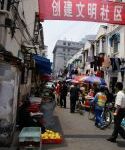 he was from out of town, no English menu, and local prices. I asked for jiaozi and baozi, and hoped for the best. And it was. So even in the most cosmopolitan area in the most cosmopolitan town in China, it’s not all Michigan Avenue and “best quality” look-alikes.
he was from out of town, no English menu, and local prices. I asked for jiaozi and baozi, and hoped for the best. And it was. So even in the most cosmopolitan area in the most cosmopolitan town in China, it’s not all Michigan Avenue and “best quality” look-alikes.
We also got to the Yu Garden, a tourist spot in the old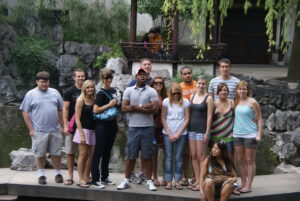 Chinese city at least for a hundred years (and I have the postcards in my collection to prove it). Now surrounded by the “City God Mall,” the Garden was an estate of a Ming dynasty official (built for his parents–recommended as a gift from the class to their teachers), who had both money and taste. It had its own opera house, rocks brought in with wondrous shapes from Tai Lake, mahogany furniture (that frankly looked uncomfortable, but we weren’t allowed to sit in it anyway), and the ponds and hills that combined make up the word for scenery in Chinese. Even with the crowds, and even surrounded by 15 million Shanghainese, it provides the serenity that the rich could afford.
Chinese city at least for a hundred years (and I have the postcards in my collection to prove it). Now surrounded by the “City God Mall,” the Garden was an estate of a Ming dynasty official (built for his parents–recommended as a gift from the class to their teachers), who had both money and taste. It had its own opera house, rocks brought in with wondrous shapes from Tai Lake, mahogany furniture (that frankly looked uncomfortable, but we weren’t allowed to sit in it anyway), and the ponds and hills that combined make up the word for scenery in Chinese. Even with the crowds, and even surrounded by 15 million Shanghainese, it provides the serenity that the rich could afford.
Bear in mind, as I think I’ve said millions of times, quoting Deng Xiao ping, “To be rich is glorious.” As true in the Ming Dynasty as today. In other words, study hard.
Good morning to me, good evening to you. Two more days here–thence to Xiamen.